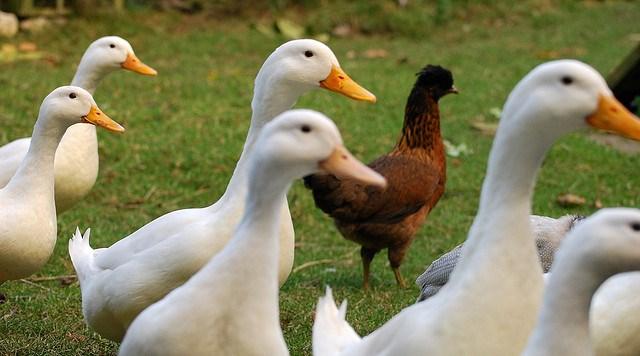A new region of France has now been hit with highly pathogenic avian flu, as the head of the World Organization for Animal Health (OIE) says he doesn't expect a US-type outbreak because of different farming methods and lower virus virulence, according to media reports.
The OIE, meanwhile, has posted details on three of the country's outbreaks, as well as on another outbreak of highly pathogenic H5N6 avian flu in Vietnam.
H5N9 in new region
The new outbreak in France, reported today by Reuters, occurred on a duck farm in the Pyrenees-Atlantiques department in Aquitaine region, the first time that region has had an outbreak this year. Other regions affected by the 13 outbreaks of high-path avian flu strains are Dordogne, Landes, Haute-Vienne, and Gers, all in southwestern France.
The farm houses 1,500 ducks, and H5N9 was confirmed as the strain, marking the third outbreak involving that strain. Before this fall's outbreak, France had not seen an avian flu outbreak in poultry in 8 years. In addition to H5N9, which until this month had never before been detected in Europe, H5N1 and H5N2 strains have also been confirmed.
France is Europe's top agricultural nation, and the impact of the virus has come at a crucial time for the country's foie gras producers. Demand for the delicacy typically peaks during the year-end holiday season. The country is facing restrictions of its poultry products and live birds from its trading partners, including Japan, France's largest foie gras importer, Reuters noted.
OIE head: Outbreak unlikely to rival US's
The surge in avian flu outbreaks in France is unusual—especially given that it involves three strains—but it is unlikely to turn into a crisis like that seen in the United States earlier this year, when almost 50,000,000 poultry became infected, OIE Director-General Bernard Vallat, DVM, told Reuters yesterday.
"We are not in a situation like the one in the United States because the breeding methods are different and the strains less virulent," Vallat said.
"Poultry farming in the departments hit is extremely active, notably for foie gras, but finally it did not spread that fast unlike other situations we have known where there were a lot of outbreaks," he said, referring to the US situation.
Vallat also noted that H5N2 and H5N9 have never been found in humans and that the H5N1 strain found in France is different from the Asian one that has caused hundreds of human cases and deaths in recent years. He also stressed avian flu cannot be transmitted by food.
OIE reports on France
In three separate reports today filed with the OIE, French officials detailed previously reported outbreaks involving H5N9, high-path H5N2, and low-pathogenic H5N2.
The H5N9 outbreak began Nov 18 and involved a farm with 12,600 broiler chickens, 4,000 guinea fowl, 3,500 capons, and 960 ducks in Landes region. Farmers had noticed sudden death in the guinea fowl.
Of 21,060 poultry, 400 died from the virus, and the rest were euthanized to contain the outbreak. It was the second H5N9 report filed by French authorities, 2 days after they confirmed a separate outbreak in the same region.
The high-path H5N2 virus struck a farm in Gers region in an outbreak beginning Nov 27, according to a second OIE report. The virus killed 250 of 8,300 ducks, and the rest were culled. Officials had previously filed reports with the OIE on Dec 2 and Dec 8 involving the same strain in Dordogne region.
The low-path H5N2 outbreak occurred on a farm in Aveyron region and is not included in the list of 13 outbreaks caused by high-path strains. The virus was detected in a flock of 6,120 ducks during routine surveillance. All the birds were destroyed.
H5N6 in Vietnam
In Vietnam, meanwhile, the H5N6 strain was confirmed in a backyard poultry flock in Quang Ninh province in the north, according to a fourth OIE report yesterday.
The outbreak began Aug 8 and involved a flock of 705 birds. Officials reported 500 H5N6 cases and 100 deaths. All surviving birds were culled to prevent disease spread.
Vietnam has reported numerous H5N6 avian flu outbreaks this year.
See also:
Dec 11 Reuters report on new outbreak
Dec 10 Reuters story on Vallat interview
Dec 10 OIE report on H5N9 in France
Dec 10 OIE report on high-path H5N2 in France
Dec 10 OIE report on low-path H5N2 in France
Dec 10 OIE report on H5N6 in Vietnam























